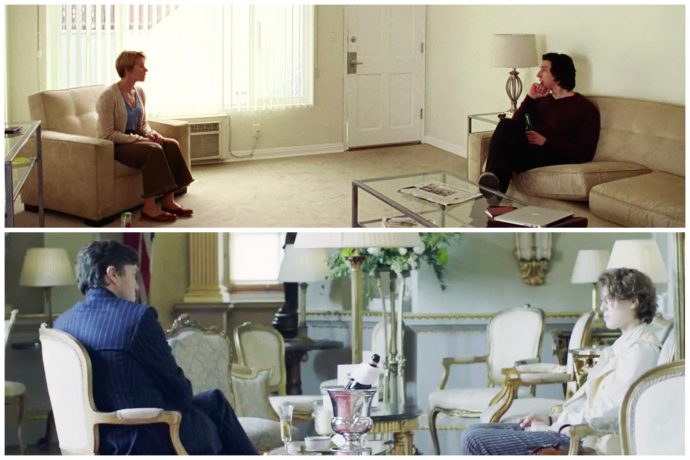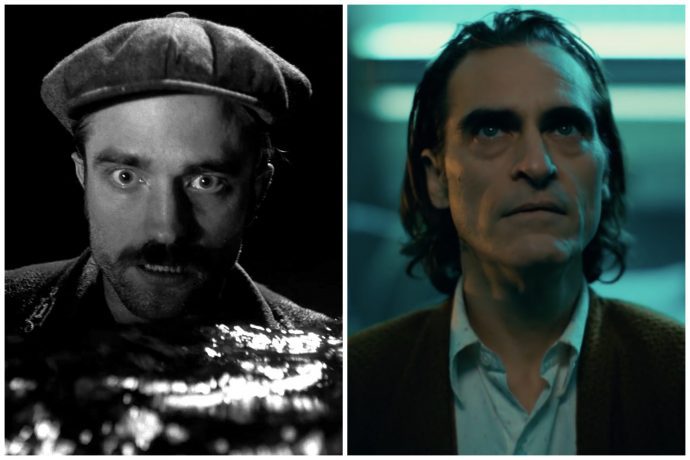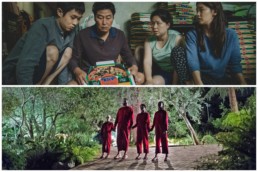In 2019, Which Films Felt Spiritually Connected?
Parasite and Us, Joker and The Lighthouse, and more.
There’s no doubt that every film has its own singular and unique vision that is expressed by its filmmaker. However, it can be found that when films are released throughout the year, certain ideas can be seen between films that directors are all subconscious of circling. And when different films circle the same idea, those ideas become even more profound; It can reveal a universal truth that gets amplified.
In looking back on the films that I watched in 2019, I found several films that felt spiritually connected.
Modern Masters Contemplate the End of Their Eras in The Irishman & Once Upon a Time in… Hollywood

Despite what you may have heard, The Irishman isn’t just another gangster movie. While Martin Scorsese’s decades-spanning crime epic does follow the life of a hitman, the film is not another celebration of criminals like Goodfellas is. In The Irishman, Scorsese, now all of 77 years old, seems to be very much consciously reflecting on the end of his filmmaking career. To that end, he chooses to depict the story of Frank Sheeran (Robert DeNiro) through Sheeran recounting his life’s end in an assisted living facility. Amidst the bloodshed and kills he’s seen and done over his life, perhaps the heaviest blow that Scorsese deals to the audience is when Sheeran asks a nurse, maybe two generations his senior, if she knows who Jimmy Hoffa is – the same Hoffa (Al Pacino) that we see Sheeran dedicate his life to over three and a half hours in the film. After she admits to not knowing who the infamous union leader was, it feels as if Scorsese himself is confronting a larger existential question: if after a lifetime of achievements, if they go unrecognized – and especially by the ones you love, did it mean anything?
So too does Quentin Tarantino reflect on a similar sense of displacement in a shifting culture, as Once Upon a Time in… Hollywood shows former leading man Rick Dalton (Leonardo DiCaprio) struggling to admit that his best days are behind him and that he’s eclipsed from relevancy. It’s comical when he decries all of the “Goddamn hippies!” at every moment they pop up, revealing his anxiety to an uncertain future. Tarantino’s and Scorsese’s films both act as meta-tributes to the things they’re known for doing best (Scorsese making a “gangster” film, Tarantino making a showy Hollywood romp). However, both directors imbue a piece of tragedy in their leading men’s futile attempts to preserve a time that they know, or knew. It’s heartbreaking that both Irishman and Hollywood end with each of their leading men – after having endured a lifetime of battles and achievements, and who should feel triumphant for it – being very much alone. After a lifetime of great accomplishments between Scorsese and Tarantino, these films feel as if even masters can feel a sense of emptiness and longing.
Rebirth At The End of Relationships, in Marriage Story & The Souvenir

Two of my favorite films of last year were both beautifully made films about tumultuous relationships, and how the people in those relationships struggle to recover after bitter ends. In Marriage Story, writer-director Noah Baumbach shows that although two people can start out being so right for each other, sometimes they will grow apart. This is seen through the dissolving of marriage between theater director Charlie (Adam Driver) and his muse Nicole (Scarlett Johansson). While Marriage Story starts with Nicole’s realization that she wants something different in her life, the film ends with Charlie (Driver) having to re-discover himself, and re-invent after heartbreak.
In another deeply personal film (also circling auto-biography), British director Joanna Hogg’s The Souvenir tells the story of a demure young woman, Julie (Honor Swinton Byrne), whose relationship with Anthony (Tom Burke) is entirely co-dependent, even though his lifestyle is incredibly destructive and dangerous. While The Souvenir wasn’t as big of a film as Marriage Story, it is one of the most rewarding movie-going experiences I had last year for its emotional vulnerability. While both films shows the emotional bottom that occurs when a life shatters, each film shows how we can pick ourselves back up, and sometimes that’s exactly what we need to be re-born.
The Lighthouse & Joker Show There’s Art in the Madness

Blame it on the relentless stream of sensational news headlines or the current state of American politics, but 2019 felt like another strange and unsettling wobble in our nation’s struggle to maintain shared national sanity. With the popularization of “fake news,” it feels like people are growing more comfortable with living in their self-prescribed truths, which leaves the very concept of objectivity as something that no longer needs to be agreed on. Yes, there is a massive danger to that. Two films embodied this slip into madness perfectly: writer-director Robert Eggers, who directed 2015’s The Witch, returned with The Lighthouse, a stormy black and white tale of two lighthouse workers who struggle to stay sane while isolated together. The film features two incredible performances, including Willem Dafoe as a craggy old veteran, but it’s Robert Pattinson through which we see the actual unraveling of sanity. He begins the film convinced of his rightness, but after demented seagulls and dangerous mermaids appear, he loses his grasp on what’s real and what’s not.
And of course, what film embodied losing grip on reality better than Joaquin Phoenix, who took on the title role of playing a failed standup turned murderous terrorist in Joker. While Joker was met with concern for prophetizing a psyche of white male frustration (a very real issue in today’s culture), all of these deranged performances – including Pattinson and Dafoe – should be applauded. They created such resonant characters that relieved some tension to a fractured male psyche, and yet were still inspiring in their artistry.
Social Commentary Disguised in Genre, in Parasite & Us

Sometimes, the more uncomfortably real a problem or issue is, the more that idea needs to be disguised through something more allegorical so that it can be better understood. It was so refreshing and revitalizing to see each of these next two films in theaters, as both audiences were electrified while watching. I saw Bong Joon Ho’s Parasite after it had been around for a little while, and yet I didn’t know anything about it going in (which is exactly how you should see it). Parasite starts as a whip-smart comedy about a low-income family that dupes a more affluent family into hiring each of them in their home, then becomes a head-spinning twisty horror that reveals another level to this concept. Ultimately, it becomes a politically charged piece (like all of Bong Joon Ho’s films) that highlights the divide in the world through economic inequality.
Jordan Peele’s follow up to Get Out, Us, uses a classic horror set up to show a film about a family and their doppelgängers who seek revenge in the world by taking their place all across America. Peele has proven that he’s as aware of the meaning of every shot, and every piece of what goes into a film (much like this video essay shows) so that horror can be effective in informing people of real-world issues.
Ryan Rojas
Ryan is the editorial manager of Cinemacy, which he co-runs with his older sister, Morgan. Ryan is a member of the Hollywood Critics Association. Ryan's favorite films include 2001: A Space Odyssey, The Social Network, and The Master.


